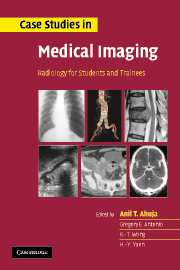Preface
Published online by Cambridge University Press: 10 December 2009
Summary
Radiology (Medical Imaging) now plays a pivotal role in modern medical practice. Clinical decision making depends on timely and accurate interpretation of imaging studies particularly in acute situations. Its importance in daily clinical practice is reflected by the fact that almost no patient leaves the hospital without undergoing an imaging study. Many clinicians now need to interpret images themselves and the information provided is particularly useful for minimally invasive treatment. It is therefore essential that imaging take its rightful place in the Medical School Core Curriculum so that future doctors have the necessary knowledge and skills to provide high quality medical care to the community they serve.
Radiology is a ‘visual’ science and is best taught and learnt viewing images rather than text alone. These images can be used to demonstrate anatomy, physiology, pathology (in cross-section, real time, 3D, multi-planar and virtual reality) and are a powerful tool when combined with relevant clinical information. Its applications cover every aspect of medicine and across all specialties making radiology the key to prompt diagnosis and management. Future doctors must therefore be familiar with all aspects of Radiology (diagnostic and interventional). It is with this in mind that ‘Case Studies in Medical Imaging: Radiology for Students and Trainees’ is written.
Radiology is constantly being revolutionized by rapidly advancing technology. There is a wealth of encyclopedic radiology textbooks (some of which have been used in the preparation for this book) available in the market for residents undergoing specialist training.
- Type
- Chapter
- Information
- Case Studies in Medical ImagingRadiology for Students and Trainees, pp. viii - xPublisher: Cambridge University PressPrint publication year: 2006

